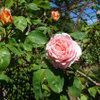Soil testing and amending
vettin
13 years ago
Related Stories

LANDSCAPE DESIGNHow to Shape a Rain Garden and Create the Right Soil for It
Learn how to grade, lay out and amend the soil in your rain garden to support your plants
Full Story
GARDENING GUIDESGrow a Beautiful Garden in Alkaline Soil
Got alkaline soil? Learn how to manage it and the many beautiful plants that will thrive in this ‘sweet’ soil
Full Story
GARDENING GUIDESGet the Dirt on Your Garden’s Soil
Understand how your soil supports your plants so you can ensure your garden’s success
Full Story
GARDENING GUIDESHow to Stop Worrying and Start Loving Clay Soil
Clay has many more benefits than you might imagine
Full Story
GARDENING GUIDESHave Acidic Soil in Your Yard? Learn to Love Gardening Anyway
Look to acid-loving plants, like conifers and rhododendrons, to help your low-pH garden thrive
Full Story
GARDENING GUIDESGardening Solutions for Dry, Sandy Soils
Has your desert or beachy site withered your gardening creativity? Try these ideas for a beautiful, easy-care landscape
Full Story
GARDENING GUIDESGardening Solutions for Heavy Clay Soils
What’s a gardener to do with soil that’s easily compacted and has poor drainage? Find out here
Full Story
GARDENING GUIDESHouzz TV: Make a Worm Bin for Rich Soil and Happy Plants
A worm-powered compost bin that can fit under a sink turns food scraps into a powerful amendment for your garden. Here’s how to make one
Full Story
FARM YOUR YARDHow to Get Good Soil for Your Edible Garden
The nutrients in your soil feed the plants that feed you. Here are tips on getting it right — just in time for planting season
Full Story
GARDENING GUIDESThe Poop Scoop: Enrich Your Soil With Good Old Manure
Get over the ick factor already — this natural super-ingredient for soil has so many benefits, you'll wonder why you ever went chemical
Full StoryMore Discussions









michaelg
berndoodle
Related Professionals
Derry Landscape Architects & Landscape Designers · Lyons Landscape Architects & Landscape Designers · Stoughton Landscape Contractors · Dunwoody Landscape Contractors · Edwardsville Landscape Contractors · Hollywood Landscape Contractors · Northport Landscape Contractors · Pikesville Landscape Contractors · Denton Swimming Pool Builders · Grand Rapids Swimming Pool Builders · Fairfax Siding & Exteriors · Kenosha Siding & Exteriors · Panama City Siding & Exteriors · Rockville Siding & Exteriors · Waterford Siding & Exteriorsjim_w_ny
hartwood
lagomorphmom
Embothrium
berndoodle
berndoodle
elemire
berndoodle
strawchicago z5
strawchicago z5
michaelg
strawchicago z5
zack_lau z6 CT ARS Consulting Rosarian
michaelg
strawchicago z5
Embothrium